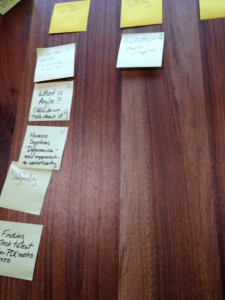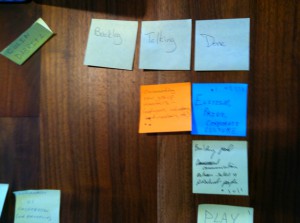(Thanks to Colin Dabritz for taking notes)
Misogyny + Bigotry in tech
- lots of incidents recently
- maybe some of this crossover from video games?
- lack of professionalism in general
- Are parts of the culture perpetuating a lack of professionalism?
- Casual culture, you feel less ‘accountable’ but you are representing a company, profession
- profession is young, no liscensure to revoke (e.g. you can’t be disbarred for unethical behavior)
- Youth culture contributes
How much prediction making do you do?
- Agile, so many unknowns can’t predict, so don’t. Manage and move.
- Sales need targets, sometimes hard deadlines.
- lost of people forget, can adjust schedule or features
- Mcconnel estimation (book)
- This is an exploration, research, not mechanized process
- Predictions are dangerous, can become constraints
- Predictions can be important to coordinate, can cause issues, why not buffer?
- Just make the development team as productive as possible
- Making predictions is natural, making promises
What kind of interruptions do you allow? How do you manage them?
- git stash – temporarily ‘stash’ work
- Kanban – focusing on the thing you are doing
- Feel about – “oh great, I’m accumulating inventory in my warehouse that’s costing me money”
- (who fights fires this week?)
- allow? can’t choose interruptions, distractions
- (context switching is expensive)
- (understanding management vs maker schedule)
- (true fires, understand the cost)
- (have a good product manager, prioritize properly)
How do you manage your brain?
- Problems in work and life don’t always give you a choice
- Do what you want to be good at, e.g. if you switch to managing that’s a shift, you will lose some dev ability.
- Learning, practicing
- Taking breaks (pacing)
- Managing stress
- Learn your rhythms, 90 mis is a magic number for me, give yourself time, find others who can handle your rhythm
- Be mindful of the things you put into your brain (e.g. sources of news, how they make you feel)
- your environment, habbits
- surround with smart[er] people, choose your work, environments
- exercise, diet, socialization
- Space – space where it’s easy to access healthy things, exercise, standing desks
- – Avoid stress, ability to move and adjust, eat good food
- Competitive can be stressful, but can also be positive, pushing you.
- Stress spectrum, can be different kinds
- autonomy, mastery, purpose
- too comfortable, not exploring new things
- sharpen the saw, be attentive, prioritize yourself and your brain, get coaching
Forward thinking companies
- Have you heard of OKCupid? Was it because of the service, or the blog posts with data?
- How is this measured?
- Being trusted experts. (Unbounce)
- Who do you think of as forward thinking? Company providing fungus that acts like styrofoam
- Cellular level mechanism, nanotechnology, nano power generation in clothing
- SpaceX
- Used to think of google as a forward thinking company
- Challenging norms
- Code schools
- Connecting
- trying new things
- Try to solve a problem that doesn’t affect just the privilege of the bay area
- Companies that measure
- Watsi
- Do VCs and the startup industry promote this?
- Pharmacutical companies, make or break on FDA approval
What’s hard or challenging?
- Simple – to make or do simple things, always harder than the compacted.
- e.g. quitting smoking. Very simple, very challenging.
- Changing habits
- Software – making it simple, elegant is hard.
- Understanding the problem
- Quick feedback loop makes things easier, long or complex feedback loop is much harder
- People issues are a long feedback loop
- People are hard
- Department has “solutions” in the name, but uninterested in the solutions, much more interested in the problems
- The problem is you don’t understand the problem
- Starting with the wrong question, finding the right question
- Exploring the landscape
- Follow up, follow through, ideals
- Doing the RIGHT thing now, vs the fast easy thing
- Working in teams
- Others perspective, doing the right thing for everyone
- Being ethical for all stakeholders
- The unknown unknowns
- Missing pieces, missing requirements
- Communicating ideas, sharing vision
- (Vulnerability, taking real personal risk)
Learning Center
- making a space where learning happens
- Where existing engineers can mentor, and improve their own skills
- Book: The quick start guide to the five years of accelerated learning Willem + Diana Larsen
- First thing you do is take care of peoples basic needs (comfortable, fed, relaxed, welcome)
- Mix between – solid, things aren’t moving, not a good environment. gas – chaotic, moving too much. Liquid – move enough
- Zone of proximal development
- Whiteboards – Whiteboard paint (“winking”)
- What makes a learning environment welcoming?
- What motivates people to learn?
- Parents sense of expectation was a big driving force in undergrad
- Suddenly having to come up with intrinsic motivation was hard
- Book: “Confessions of a buccaneer scholar”
Programers are to sysadmins as doctors are to surgeons
(missed notes here)
Vacation – do you check-in or not?
- “what is a ‘Vacation'”? (sarcasm)
- What types of responsibilities does your job have?
- If you’re at a job/company
- (lost notes)




